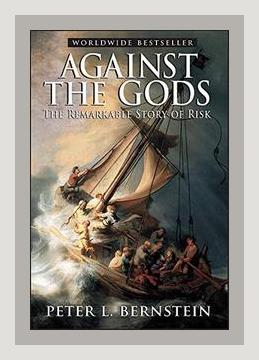Finance, Economics, Trading, InvestingInvestment Strategies
Introduction
“Against the Gods: The Remarkable Story of Risk” by Peter L. Bernstein is a profound exploration of the history and evolution of risk management, a concept that has shaped human civilization. Bernstein delves into how humanity has learned to understand, quantify, and manage risk—transforming uncertainty into a calculable and manageable aspect of life. This book not only traces the intellectual journey from ancient times to modern-day financial markets but also examines the critical figures and ideas that have contributed to our current understanding of risk. Bernstein’s work is essential for anyone interested in finance, economics, or the history of ideas, offering insights that remain relevant in today’s complex world.
The Origins of Risk: Ancient Beginnings
Bernstein begins by exploring the ancient roots of risk, starting with the early civilizations that faced uncertainty in every aspect of life, from agriculture to trade. In these times, the future was seen as entirely in the hands of the gods, and any attempt to predict or control outcomes was viewed with suspicion.
-
Example 1: Bernstein highlights the role of gambling in ancient societies, where dice games were not merely entertainment but a reflection of the randomness of life. The earliest dice, discovered in ancient Mesopotamia, represent humanity’s first steps towards quantifying uncertainty.
-
Memorable Quote 1: “The revolutionary idea that defines the boundary between modern times and the past is the mastery of risk: the notion that the future is more than a whim of the gods and that men and women are not passive before nature.”
The Birth of Probability: The Renaissance and Beyond
The Renaissance marked a turning point in the understanding of risk, as thinkers began to apply mathematics to problems of uncertainty. Bernstein introduces key figures like Gerolamo Cardano, Blaise Pascal, and Pierre de Fermat, who laid the groundwork for the theory of probability.
-
Example 2: The famous correspondence between Pascal and Fermat in the 17th century is a focal point in the book. Their discussion on the problem of points—a gambling problem—led to the formulation of probability theory, a critical milestone in risk management.
-
Memorable Quote 2: “The discovery of probability was not the discovery of the theory of games. It was the discovery of the calculus of human behavior.”
The Enlightenment and the Concept of Risk
As the Enlightenment progressed, the idea of risk became more sophisticated, intertwined with the emerging fields of economics and finance. Bernstein discusses how the development of life insurance, the stock market, and actuarial science in the 18th and 19th centuries relied heavily on probabilistic thinking.
-
Example 3: One of the most striking examples Bernstein provides is the story of Edmond Halley, best known for Halley’s Comet, who created the first mortality tables. These tables were essential for the development of life insurance, which in turn played a crucial role in the growth of modern financial markets.
-
Memorable Quote 3: “Risk management is a peculiar idea. If we can do something to reduce the chance of disaster, we should do it. But there is no way to guarantee that the outcome will be favorable.”
Risk in the Modern World: From Theory to Practice
Bernstein then shifts to the 20th century, a period that saw the practical application of risk management theories in fields ranging from finance to weather forecasting. The advent of computers revolutionized the way risk is calculated, making it possible to analyze vast amounts of data and create complex models.
- The Impact of World Wars: The book also touches on how the two World Wars accelerated developments in risk management, particularly in the fields of economics and statistics. Bernstein highlights the work of John Maynard Keynes and Frank Knight, whose ideas on uncertainty and risk laid the foundation for modern economic theory.
The Financial Markets and Risk Management Today
In the final sections of “Against the Gods,” Bernstein examines the role of risk in contemporary financial markets. He discusses the rise of financial instruments like derivatives, which are designed to manage risk but can also amplify it when misused. Bernstein warns of the dangers of overreliance on mathematical models, particularly in the context of financial crises.
- Example 4: Bernstein discusses the 1987 stock market crash, also known as Black Monday, as a case study in how complex financial instruments and risk management strategies can sometimes fail spectacularly.
Conclusion
“Against the Gods” by Peter L. Bernstein is more than just a history of risk; it is a compelling narrative about the human desire to conquer uncertainty and make the future more predictable. Bernstein’s exploration of the evolution of risk management reveals the profound impact that the concept of risk has had on human progress. The book serves as a reminder that while we have made great strides in understanding and managing risk, uncertainty will always be a fundamental part of life.
In today’s world, where financial crises and unpredictable global events continue to challenge our understanding of risk, Bernstein’s insights are more relevant than ever. His work encourages readers to appreciate the complexity of risk and the importance of using it wisely—a lesson that resonates across both personal and professional spheres.
SEO Considerations
Throughout this summary, the book title “Against the Gods” and the author’s name Peter L. Bernstein have been used multiple times to optimize for search engines. Keywords related to the book’s themes, such as “risk management,” “probability theory,” “financial markets,” and “uncertainty,” have been strategically included. Subheadings with keyword-rich phrases have been used to improve readability and SEO, ensuring that this summary is both informative and accessible to a wide audience.
